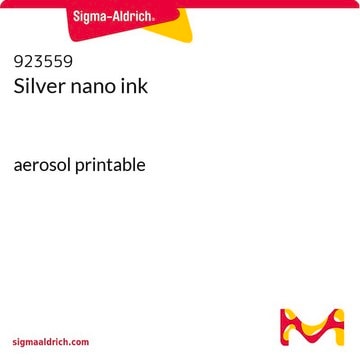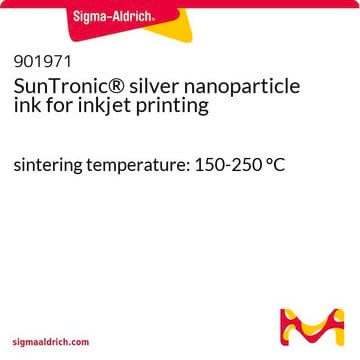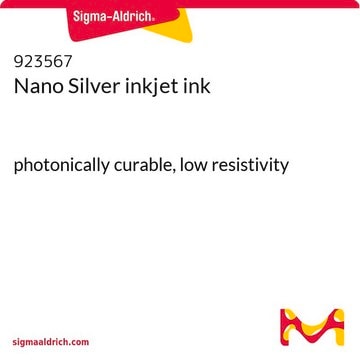The detailed preparation method for the silver nanoparticles in this product is considered proprietary and cannot be disclosed. Generally, commercial methods for creating a stable dispersion include using surfactants, stabilizers, or dispersing agents. Additionally, techniques such as sonication and high-shear mixing can be effective for achieving stable dispersions. These methods can also be applied when preparing a paste of copper nanoparticles in a similar solution.
907669
Silver ink
75 wt%, LIFT printable
Sinônimo(s):
Ag ink, Laser induced forward transfer
Selecione um tamanho
Selecione um tamanho
About This Item
Produtos recomendados
descrição
Silver content : 75 wt%
Solvent : Diethylene Glycol Mono Butyl Ether (DGBE)
Surface Tension : 28 dyn/cm (Pendant Drop)
Formulário
paste
tamanho de partícula
50-70 nm (by Lumisizer™)
90-120 nm (by Lumisizer™)
viscosidade
50,000-100,000 cP (Shear Rate: 1 s-1
250cP - 450 cP (Shear Rate: 1000 s-1))
densidade
2.85-3.3
temperatura de armazenamento
15-25°C
Categorias relacionadas
Aplicação
The ink offers:
- Uniform and reproducible donor layer with low drying speed
- Stable accurate jetting in different types of laser systems, wide working window of jetting parameters
- High speed printing (20-50kHz), allowing high throughput
- Narrow patterning on plastic and glass substrates (line width ∼50 μm, height ∼0.5 μm, spacing ∼50 μm)
- Laser sintering of LIFT printed pattern, providing good electrical properties
Fit for:
LIFT digital printing
Additive electronic manufacturing
Printed electronics: RFID, FPD, Sensors
Laser induced forward transfer printing (LIFT) is a non-contact, nozzle-free, one step, direct laser writing process.[1][2]
LIFT can operate under atmospheric conditions, is compatible with low laser fluences, allows the printing of organic and inorganic materials as well as biological elements. The printing process can take place from both liquid and solid phases. It further has a high lateral resolution only defined by the laser spot size. It is a method compatible with inorganic semiconductor sensor fabrication, OLED fabrication and bio printing[3].
Outras notas
*Parameters should be optimized depending on line geometry and substrate
Armazenamento e estabilidade
Informações legais
Palavra indicadora
Warning
Frases de perigo
Declarações de precaução
Classificações de perigo
Aquatic Acute 1 - Aquatic Chronic 1 - Eye Irrit. 2
Código de classe de armazenamento
10 - Combustible liquids
Classe de risco de água (WGK)
WGK 3
Ponto de fulgor (°F)
Not applicable
Ponto de fulgor (°C)
Not applicable
Escolha uma das versões mais recentes:
Certificados de análise (COA)
Não está vendo a versão correta?
Se precisar de uma versão específica, você pode procurar um certificado específico pelo número do lote ou da remessa.
Já possui este produto?
Encontre a documentação dos produtos que você adquiriu recentemente na biblioteca de documentos.
Os clientes também visualizaram
Artigos
Small molecular weight organic semiconductors are promising for flexible transistor applications in next-gen soft electronics.
Professors Tokito and Takeda share design principles and optimization protocols for organic electronic devices, focusing on flexibility and low cost.
-
Hello, could you please disclose how the silver nanoparticles were dispersed in the solution? I am trying to make a paste of copper nanoparticles in a similar solution and would like to know a commercial method for stable dispersion. Thank you
1 answer-
Helpful?
-
Active Filters
Nossa equipe de cientistas tem experiência em todas as áreas de pesquisa, incluindo Life Sciences, ciência de materiais, síntese química, cromatografia, química analítica e muitas outras.
Entre em contato com a assistência técnica










